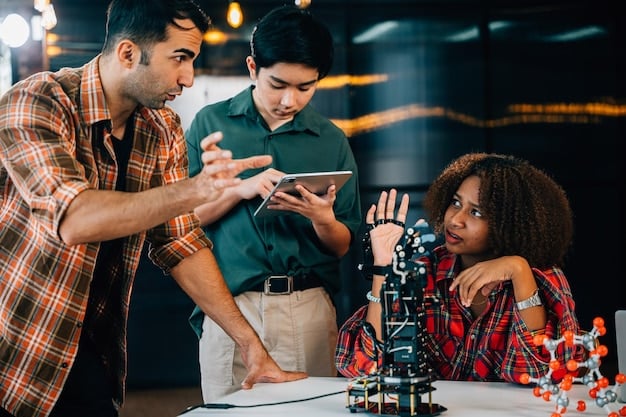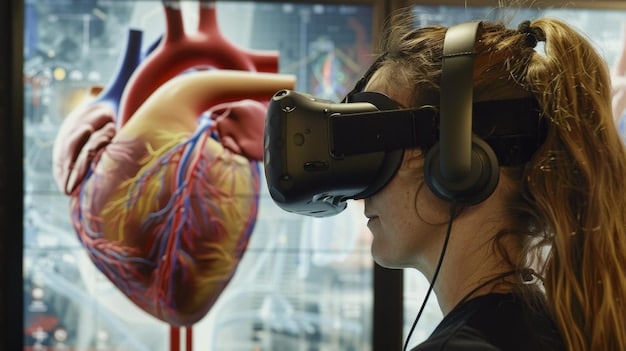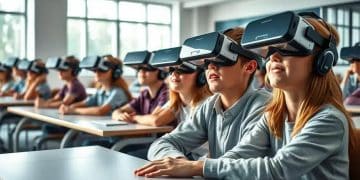Emerging Trends in STEM Education: How Students Can Prepare

Emerging trends in STEM education include interdisciplinary learning, personalized education, and increased use of technology like AI and virtual reality, requiring students to develop adaptability, critical thinking, and digital literacy skills to succeed.
The landscape of STEM (Science, Technology, Engineering, and Mathematics) education is rapidly evolving. To help students thrive in this dynamic environment, it’s crucial to understand **what are the emerging trends in STEM education and how can students prepare** for these changes.
Understanding the Interdisciplinary Approach in STEM
One of the foremost trends reshaping STEM education is the interdisciplinary approach. Unlike traditional siloed subjects, this method integrates different STEM fields, promoting a more holistic understanding and problem-solving capability.
Why Interdisciplinary Learning Matters
Interdisciplinary learning encourages students to connect concepts from various STEM disciplines, fostering creativity and critical thinking. It reflects real-world scenarios where problems often require solutions that draw from multiple fields.
Examples of Interdisciplinary STEM Projects
Consider projects such as designing a sustainable urban farm, which combines biology, engineering, and technology. Another example is creating a smart home system, integrating computer science, electrical engineering, and architecture. These projects promote collaborative skills and deepen understanding through practical application.
- Promotes holistic understanding
- Fosters creativity and critical thinking
- Mirrors real-world problem-solving
- Encourages teamwork and collaboration
In conclusion, the interdisciplinary approach is vital for preparing students for the complexities of modern STEM careers. By integrating various fields, it fosters a more adaptable and innovative mindset.
The Rise of Personalized Learning in STEM
Personalized learning is another significant trend, adapting educational approaches to meet the individual needs and learning styles of each student. This method ensures that students receive tailored instruction, maximizing their potential in STEM fields.

Benefits of Personalized Education
Personalized education allows students to learn at their own pace, focusing on areas where they need more support. This increases engagement and motivation, leading to better learning outcomes. It also accommodates diverse learning styles, ensuring every student can succeed.
Tools and Technologies Supporting Personalized STEM Education
Various technologies, such as adaptive learning platforms, AI-powered tutoring systems, and customized online resources, are facilitating personalized learning in STEM. These tools provide real-time feedback and adjust the difficulty level to match the student’s current understanding.
- Caters to individual learning styles
- Provides tailored instruction
- Increases student engagement and motivation
- Utilizes adaptive learning technologies
In summary, personalized learning enables a more effective and engaging STEM education by addressing the unique needs of each student, leading to improved academic performance and a stronger interest in STEM fields.
Integrating Artificial Intelligence (AI) in STEM Education
Artificial Intelligence (AI) is increasingly becoming a key component of STEM education. AI tools and platforms are transforming how students learn and how educators teach, providing new opportunities for exploration and understanding.
AI as a Tutoring and Learning Assistant
AI-powered tutoring systems offer personalized instruction, identify knowledge gaps, and provide targeted feedback to students. These systems can adapt to each student’s learning style and pace, offering customized support and guidance.
AI in Data Analysis and Visualization
AI tools are also used to help students analyze and visualize complex data sets, allowing them to identify patterns and draw meaningful conclusions. This prepares them for data-driven decision-making in various STEM careers.
The integration of AI enables students to explore complex concepts through simulations and virtual experiments. This hands-on experience deepens their understanding and enhances their problem-solving skills.
To conclude, integrating AI in STEM education empowers students with advanced tools and capabilities, preparing them for the future workforce where AI will play a central role.
Virtual Reality (VR) and Augmented Reality (AR) in STEM Learning
Virtual Reality (VR) and Augmented Reality (AR) technologies are revolutionizing STEM education by providing immersive and interactive learning experiences. These tools allow students to explore complex concepts in a visually engaging and practical manner.

VR for Immersive Simulations
VR enables students to immerse themselves in simulated environments, such as exploring the human anatomy in 3D or conducting virtual experiments in a chemistry lab. This hands-on experience enhances their understanding and retention of complex information.
AR for Interactive Learning
AR overlays digital information onto the real world, providing interactive learning experiences. For example, students can use AR apps to visualize mathematical concepts or explore the structure of a building in real time.
- Provides immersive learning experiences
- Enhances understanding and retention
- Offers hands-on virtual experiments
- Makes learning more engaging and interactive
In essence, VR and AR technologies make STEM education more interactive and engaging, fostering a deeper understanding and appreciation for the subject matter. This prepares students for future careers where these technologies are increasingly prevalent.
Focus on Developing Essential Skills: Adaptability, Creativity, and Critical Thinking
Beyond specific STEM subjects, developing essential skills such as adaptability, creativity, and critical thinking is crucial for student success. These skills enable students to thrive in a rapidly changing world and to solve complex problems effectively.
\
Adaptability in a Changing World
Adaptability is the ability to adjust to new conditions and challenges. In the context of STEM, this means being open to new technologies, methods, and ideas. Students must be prepared to continuously learn and update their skills throughout their careers.
\
Fostering Creativity and Innovation
Creativity involves generating new ideas and approaches to solve problems. STEM education should encourage students to think outside the box and to explore unconventional solutions. Innovation requires a willingness to experiment and to learn from failures.
\
Promoting Critical Thinking and Problem-Solving
Critical thinking is the ability to analyze information objectively and to make reasoned judgments. Students must be able to evaluate evidence, identify biases, and draw logical conclusions. Problem-solving involves applying critical thinking skills to find effective solutions to complex issues.
To summarize, nurturing adaptability, creativity, and critical thinking skills is essential for preparing students for the challenges and opportunities of the future. These competencies will enable them to excel in STEM careers and to contribute meaningfully to society.
Preparing for the Future of STEM Careers
As the STEM landscape continues to evolve, students need to be proactive in preparing for the future of STEM careers. This involves staying updated with technological advancements, developing a strong foundation in core concepts, and seeking practical experience.
Staying Updated with Technological Advancements
Students should actively follow industry trends, participate in online courses and workshops, and engage with professional networks to stay informed about the latest technological advancements. This continuous learning is vital for remaining competitive in the job market.
Building a Strong Foundation in Core Concepts
A solid understanding of fundamental principles in mathematics, science, and engineering is essential. Students should focus on mastering these core concepts before moving on to more specialized topics. This strong foundation will enable them to adapt to new technologies and challenges throughout their careers.
Seeking Practical Experience
Internships, research projects, and hands-on learning opportunities provide valuable practical experience. These experiences allow students to apply their knowledge in real-world settings, develop their skills, and build their professional networks.
- Stay updated with technological advancements
- Build a strong foundation in core concepts
- Seek practical experience through internships and projects
- Develop essential soft skills
In conclusion, preparing for the future of STEM careers requires a combination of continuous learning, a strong foundation in core concepts, and hands-on experience. By focusing on these areas, students can position themselves for success in the dynamic world of STEM.
| Key Point | Brief Description |
|---|---|
| 💡 Interdisciplinary Learning | Integrates STEM fields for holistic problem-solving. |
| 🎯 Personalized Education | Tailors learning to individual needs and styles. |
| 🤖 AI Integration | Uses AI for tutoring, data analysis, and simulations. |
| 👓 VR/AR in Learning | Employs VR/AR for immersive, interactive experiences. |
Frequently Asked Questions (FAQ)
▼
Interdisciplinary learning integrates different STEM fields, fostering a holistic understanding and enhancing problem-solving by connecting concepts from various disciplines.
▼
Personalized education tailors instruction to individual needs, allowing students to learn at their own pace, improving engagement, motivation, and overall learning outcomes.
▼
AI provides personalized tutoring, assists with data analysis, and offers simulations, enhancing learning experiences and preparing students for AI-driven careers.
▼
VR and AR offer immersive simulations and interactive learning, making complex concepts more engaging and improving retention through hands-on virtual experiences.
▼
Students should develop adaptability, creativity, and critical thinking to thrive in a rapidly changing world, effectively solve complex problems, and foster innovation.
Conclusion
In conclusion, the evolving landscape of STEM education calls for a shift towards interdisciplinary approaches, personalized learning, and the integration of technologies like AI and VR/AR. By focusing on adaptability, creativity, and critical thinking, students can prepare for the future of STEM careers and contribute to innovation and progress.





